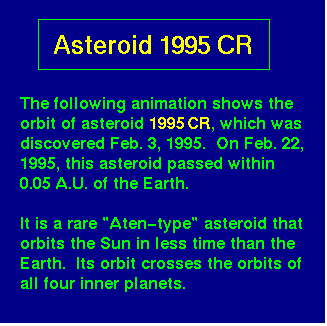Certain groups of asteroids have elliptical orbits that cross the orbit of the Earth and other inner planets. Thus, these asteroids can come very close to the Earth. This provides a rationale to study such asteroids beyond the merely scientific one.
 The adjacent animation illustrates the orbit of asteroid 1995 CR,
which was only discovered in 1995. The animation covers the two years---February 3, 1994 through February 3, 1996---at
approximately 1 month intervals, except near the time of discovery (February 3,
1995) where the interval is about 10 days.
The adjacent animation illustrates the orbit of asteroid 1995 CR,
which was only discovered in 1995. The animation covers the two years---February 3, 1994 through February 3, 1996---at
approximately 1 month intervals, except near the time of discovery (February 3,
1995) where the interval is about 10 days.
This asteroid is of a relatively rare type with an orbital period much faster than that of the Earth. Notice that its orbit crosses the orbit of all 4 of the inner planets (though not obvious here, the orbit is almost in the plane of the ecliptic). On February 22, 1995 (2 1/2 weeks after discovery), this asteroid passed within 7.5 million km of the Earth---a distance only 20 times that of the distance to the Moon (note that in the animation the sizes of the planetary disks and of the asteroid are greatly exaggerated).
Notice how rapidly the asteroid moves on the inner part of its orbit (Kepler's 2nd Law). It covers approximate half of the distance around its orbit in only about 2 months when it is near the Sun! Here is the Present Position of the asteroid 1995 CR.
One such Earth-crossing asteroid is Toutatis, which was discussed in the preceding section. Its eccentric, four-year orbit extends from just inside the Earth's orbit to the main asteroid belt, and the plane of Toutatis' orbit lies closer to the plane of the Earth's orbit than any other Earth-crossing asteroid presently known. On September 29, 2004, Toutatis will pass by the Earth at a distance of only 4 times the distance to the Moon---the closest approach to Earth of any known asteroid or comet between now and 2060. The asteroid's frequent close approaches to Earth render its orbit chaotic, so that its trajectory more than several centuries into the future cannot be predicted accurately (Ref).